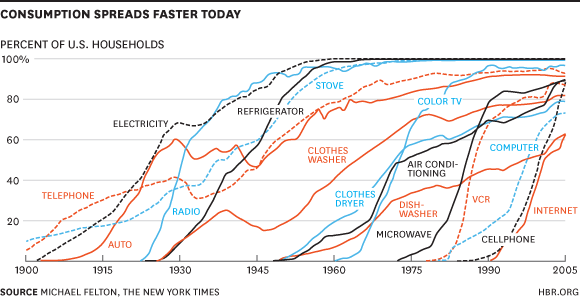From DSC:
Some of the largest waves of change that are hitting the beaches of numerous societies throughout the globe are coming from technological changes such as:
- Artificial intelligence (which includes things like machine learning, deep learning, natural language processing, personal assistants, bots, algorithms, and the like)
- Big data and analytics
- Robotics
- The digital transformation of businesses
- New forms of human computer interaction such as virtual reality, augmented reality and mixed reality
- Mobile computing
- Cloud computing
- The Internet of Things
- Wearables
- …and more
But in all of these developments, what is common amongst them is that the pace of change has changed. It’s much faster now. In fact, we are no longer on a linear path of slow, steady, incremental changes. We are now on an exponential trajectory – or pace – of change.




This new pace of change is starting to have profound implications for societies, individuals, institutions of higher education, and workforces throughout the globe. Some of these ramifications include:
- Profound modifications to the existing workforce; in some cases, staff reductions
- New fields, new positions
- New skillsets that require highly-educated individuals as well as a massive amount of additional training for existing employees
- New methods of learning and the requirement for lifelong, constant learning from here on out
- The need to become more responsive and nimble
- The need to pulse-check a variety of landscapes to ascertain the best potential strategies to pursue (in light of the potential upcoming scenarios)
Yet the changes aren’t just arising from technological changes. For institutions of higher education, there have been other areas of change that bring with them significant impact, such as:
- Decreases in state funding
- The increasing costs of healthcare and benefits for faculty, staff, and administrators
- Headwinds from demographic-related declines (depending upon one’s geographic location)
- Aging facilities and infrastructures
- …and more.
Navigating these rough waters is not easy. But the key questions now are:
- Is your institution poised to ride the waves of change or is it about to get crushed by these same waves?

- Is someone at your organization looking out for these oncoming waves?
That is, is someone pulse-checking a variety of landscapes to ascertain the trends that are developing, trends that could significantly impact your institution and/or your students?
- What are some of the ways that your organization could respond to these waves of change to positively impact the following parties?
- Your organization
What new programs could be offered at your institution? How is the level of responsiveness at your institution to these changes? - Your students
Many jobs that your students will have in their futures haven’t even been invented yet. How can you best develop them to be ready for the new, exponential pace of change? How are you helping your graduates who (increasingly) need to come back to your institution and reinvent themselves – quickly, conveniently, and cost-effectively? - Your employees
Given all of this change, the professional growth of your own faculty members, staff, and members of your administration is extremely important. How are you looking after their growth?
- Your organization
- Would you use the word “innovative” to describe the culture of your organization? That is, is your institution willing to experiment and take some calculated risks? To take no action or risks in the current environment is likely the biggest risk of all.









[…] For colleges, community colleges, & universities: The new, exponential pace of change. [Christi… […]